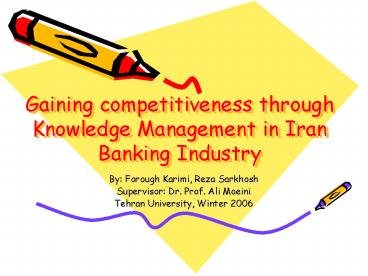Gaining competitiveness through Knowledge Management in Iran Banking Industry - PowerPoint PPT Presentation
1 / 27
Title:
Gaining competitiveness through Knowledge Management in Iran Banking Industry
Description:
Binominal Test for KM factors. Analysis of Freedman Variance ... 3.Binominal Test for KM factors. DB is not in a suitable condition; ... – PowerPoint PPT presentation
Number of Views:48
Avg rating:3.0/5.0
Title: Gaining competitiveness through Knowledge Management in Iran Banking Industry
1
Gaining competitiveness through Knowledge
Management in Iran Banking Industry
- By Forough Karimi, Reza Sarkhosh
- Supervisor Dr. Prof. Ali Moeini
- Tehran University, Winter 2006
2
Introduction
- Move from asset based society toward knowledge
based one - The vast amount of knowledge which is accessible
and should be managed - Conditions in which firms will rely greatly on
knowledge such as BPR, determining new strategic
positions, downsizing and consolidating firms.
3
Literature Review Knowledge Management
- Definition of knowledge
- Data, Information, Knowledge
- Types of knowledge knowledge spiral
- Knowledge based view of the firm
- KM definition
- KM processes
- Aspects of a comprehensive view toward KM
4
Definition of knowledge
- Knowledge is a fluid mix of framed experience,
values, contextual information, and expert
insight that provides a framework for evaluation
and incorporating new experiences and
information. Davenport Prusak,1998 - Knowledge is information within peoples minds
without a knowing, self-aware person there is no
knowledge Davenport, 1999
5
Data, Information, Knowledge
6
Types of knowledge Tacit Knowledge Vs. Explicit
Knowledge
- Tacit knowledge is personal, context-specific,
embedded in the human brain and therefore
difficult to formalize and communicate. - Conversely, explicit knowledge refers to
knowledge that can be expressed in words and
numbers and can be readily transmitted between
individuals in formal, systematic language.
7
Types of knowledge knowledge spiral
8
Knowledge based view of the firm
- Grant and Baden-Fuller make the following basic
assumptions on the knowledge-based theory of the
firm (1995) - Knowledge is the key productive resource of the
firm in terms of contribution to value added and
strategic significance. - Knowledge comprises information, technology,
know-how, and skills. - Knowledge is acquired by individuals, and in the
case of tacit knowledge is stored by individuals. - Because of the cognitive and time limitations of
human beings, individuals must specialize in
their acquisition of knowledge. - Production typically requires the application of
numerous types of specialized knowledge.
9
KM definition
- The generation, accessibility, transfer,
representation, the embedding, and facilitation
of knowledge and knowledge processes, by
developing an organizational culture that
supports and encourages the concepts of
organizational-value of knowledge,
organizational-sharing of knowledge, and
organizational-utilization of knowledge.
(Marshall et al., 1996)
10
KM processes
- Knowledge creation
- socialization,
- externalization,
- combination and
- internalization
- knowledge transfer
- transmission
- Absorption
- Knowledge application (utilization)
11
KM processes
12
Aspects of a comprehensive view toward KM
13
Literature Review Competitiveness
- Definition
- Characteristics
- KM and competitiveness
14
Definition
- When a firm earns a higher rate of economic
profit than the average rate of economic profit
of other firms competing within the same market,
then the firm has a competitive advantage in that
market (Porter, 1980). - In addition, competitiveness should not be a
simple index for measuring how competitive a
firm, an industry, or a nation is.
15
Characteristics
- competitiveness is
- long-term oriented,
- controllable,
- relative concept,
- dynamic nature
16
KM and competitiveness
- Lin (1999) suggested that establishing a
knowledge management database could lead to
benefits from data sharing and knowledge
creating. This could also increase
competitiveness. - The OECD has identified that, in the new
competitive environment, the behavior of the firm
lays the microeconomic foundations of
competitiveness, which is determined by a broad
spectrum of knowledge and information on topics
associated with the environment.
17
Methodology
- Data collection methods (Interview,
Questionnaire, Search the web and library study) - Variables dependant (Comp) and independent (KM)
- Sample of study 15 questionnaire in central
branches of 8 Iranian banks, so there was 120
questionnaire to be analyzed - Analysis methods (Freedman Variance, Binominal
Test, Correlation coefficient, Structural
Equation Modeling) - Reliability and Validity (Alpha 0.88, factorial
validity KMO test0.713) - - KMO shows that our data is suitable for
doing factor analysis - - 4 factors was identified through factor
analysis which cover almost 73 percent of KM
variable. (it is shown in next slide)
18
Conceptual model of KM factors
KM 10
DB
KM 11
KM 7
KM 8
Transfer and Share
KM 4
KM
KM 1
Storing
KM 2
KM 3
KM 5
KM 6
Application
KM 9
KM 12
KM 13
19
Findings
- Confirmatory Factor Analysis for KM model
- Correlation between KM and competitiveness
- Binominal Test for KM factors
- Analysis of Freedman Variance
20
1.Confirmatory Factor Analysis for KM model
21
2.Correlation between KM and competitiveness
22
3.Binominal Test for KM factors
- DB is not in a suitable condition
- Acquisition and storing is not in a suitable
condition - Knowledge Transferring and sharing is not in a
suitable condition - Knowledge creation and application is not in
suitable condition
23
4.Analysis of Freedman Variance
24
Suggestions Creating and Application
- - doing preliminary processes on DB
- - using advanced queries and mining techniques
- - answering this question what is the impact
of the possessed knowledge for the organization? - - having workers with high knowledge and a
group of knowledge workers
25
Suggestions Data base
- Integrating existing data storing systems into
one consolidated Data base - Updating this DB regularly
26
Suggestions Transforming and Sharing
- Creating an organizational atmosphere in which
workers could communicate their knowledge - Establishing required infrastructure to ease
organizational communication and knowledge
transfer
27
- Thank you for your attention
- Forough.karimi_at_gmail.com

